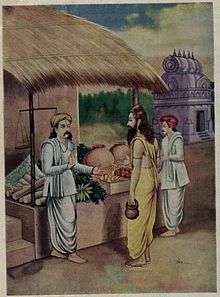Vaishya
Vaishya is one of the four varnas of the Hindu social order in India. Vaishyas are third in distinction of the four Hindu castes, comprising mainly the merchants, business or trade professions.

Traditional duties
Hindu religious texts assigned Vaishyas to traditional roles in agriculture and cattle-rearing, but over time they came to be landowners, traders and money-lenders.[1] Therefore making it their responsibility to provide sustenance for those of higher class, since they were of lower class.[2] The Vaishyas, along with members of the Brahmin and Kshatriya varnas, claim dvija status ("twice born", a second or spiritual birth) after sacrament of initiation as in Hindu theology.[3] Indian traders were widely credited for the spread of Indian culture to regions as far as southeast Asia.[4]
Historically, Vaishyas have been involved in roles other than their traditional pastoralism, trade and commerce. According to historian Ram Sharan Sharma, the Gupta Empire was a Vaishya dynasty that "may have appeared as a reaction against oppressive rulers".[5]
Modern communities
The Vaishya community consist of several jāti or subcastes, including but not limited to the Agrahari,[6] Agrawals,[7] Barnwals, Gahois, Kasuadhans, Khandelwals, Lohanas, Maheshwaris, Oswals, the Arya Vaishyas, and the Vaishya Vanis of Konkan and Goa.
References
- Boesche, Roger (1 March 2003). The First Great Political Realist. p. 24. ISBN 978-0-73910-607-5.
- Pollard. E., Roserngerg. C., Tignor, R. L. (2015). Worlds together Worlds Apart Volume 1. New York, NY: W.W. Norton &Company, Inc. p. 142. ISBN 978-0-393-91847-2.CS1 maint: multiple names: authors list (link)
- Madan, Gurmukh Ram (1979). Western Sociologists on Indian Society: Marx, Spencer, Weber, Durkheim, Pareto. Taylor & Francis. p. 112. ISBN 978-0-71008-782-9.
- Embree, Ainslie Thomas; Gluck, Carol (1 January 1997). Asia in western and world history. M.E. Sharpe. p. 361. ISBN 978-1-56324-265-6.
- Sharma, Ram Sharan (2003) [2001]. Early medieval Indian society: a study in feudalisation. Orient Blackswan. p. 69. ISBN 978-8-12502-523-8. Retrieved 26 January 2012.
- Hasan, Amir; Rizvi, Baqr Raza; Das, J. C. (2005). Singh, Kumar Suresh (ed.). People of India: Uttar Pradesh , Volume 42, Part ?. Anthropological Survey of India. p. 66. ISBN 978-81-73041-14-3.
- Bhanu, B. V.; Kulkarni, V. S. (2004). Singh, Kumar Suresh (ed.). People of India: Maharashtra, Part One. XXX. Mumbai: Popular Prakashan, for Anthropological Survey of India. p. 46. ISBN 81-7991-100-4. OCLC 58037479. Retrieved 25 April 2012.
External links

- All India Vaish Federation
